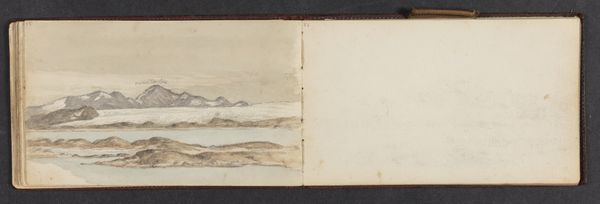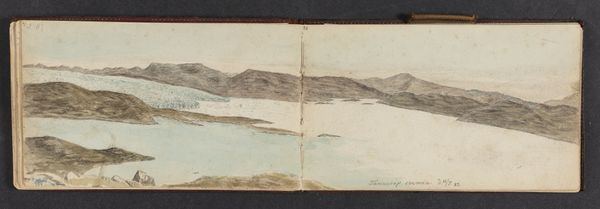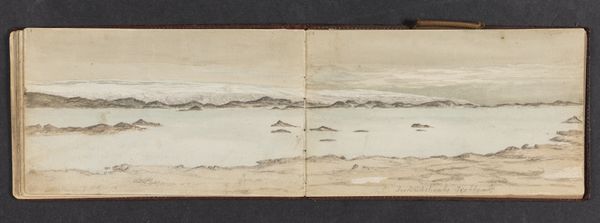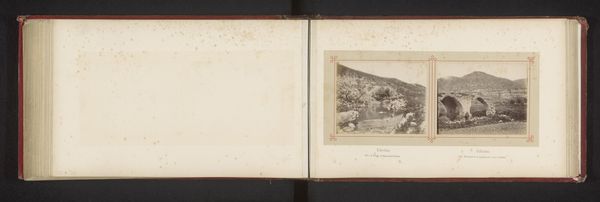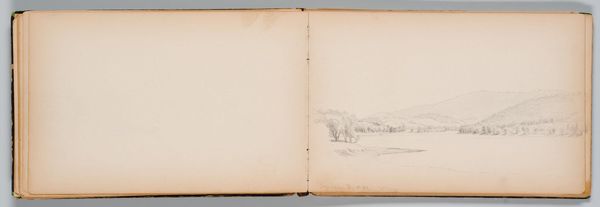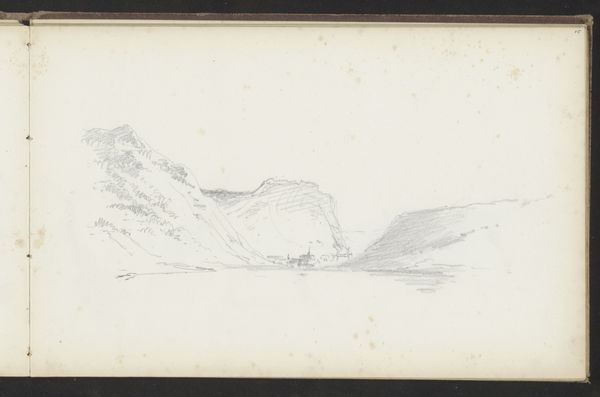
Dimensions: 120 mm (height) x 195 mm (width) x 10 mm (depth) (monteringsmaal), 113 mm (height) x 183 mm (width) (bladmaal)
Curator: Today, we're looking at "Skitse af båd," or "Sketch of a Boat," a watercolor and colored pencil drawing done en plein-air by Lars Møller in 1883. It's currently held at the SMK, the Statens Museum for Kunst. What are your initial thoughts? Editor: I'm struck by the juxtaposition of raw sketch and considered composition. There's an immediacy to the landscape rendering on the right-hand page with the more methodical notetaking and nascent image on the left. Curator: Absolutely. Møller's position as a colonial administrator in Greenland infuses this seemingly simple landscape sketch with deeper historical and political resonances. The act of sketching, of documenting, becomes a form of asserting dominance over the landscape, framing it through a Western lens. Editor: Yes, but within the frame, Møller balances a carefully observed chromatic scheme. See how the ochres and browns of the foreground gradually dissolve into the misty blues and greens of the distant mountains and sky. The composition has a very traditional symmetry with the mirrored landscape framing the boat drawing, left. Curator: Precisely, it's this romantic depiction of the "untamed" wilderness that obscures the impact of colonialism on Inuit communities. It’s an interesting paradox, because we often read romanticism as this sort of liberatory movement. But here, its deployment naturalizes power imbalances. What do you make of the boats sketched on the facing page? Editor: Well, technically speaking, those smaller pencil renderings offer structural hints: waterline, prow, hull curvature—little architectural equations nearly abstracted. Curator: Contextualizing the artist's social position demands scrutiny of the colonial gaze embedded within these portrayals, wouldn't you say? Even a landscape isn’t a neutral zone in the colonial setting, which becomes more visible in the small boats sketched on the facing page Editor: Perhaps. But I find equal value in noting how the texture of the paper—the watercolor bleed, and layering of tones—construct a deeply sensory viewing experience. It's not purely political but, fundamentally, aesthetic. Curator: Of course. What’s critical, I suppose, is staying alert to how artistic and aesthetic choices reinforce existing hierarchies. Møller’s work functions on many levels, like water, constantly refracting its surroundings. Editor: A lovely thought. A sketch offering an open vista that yields more with each deeper look.
Comments
No comments
Be the first to comment and join the conversation on the ultimate creative platform.




